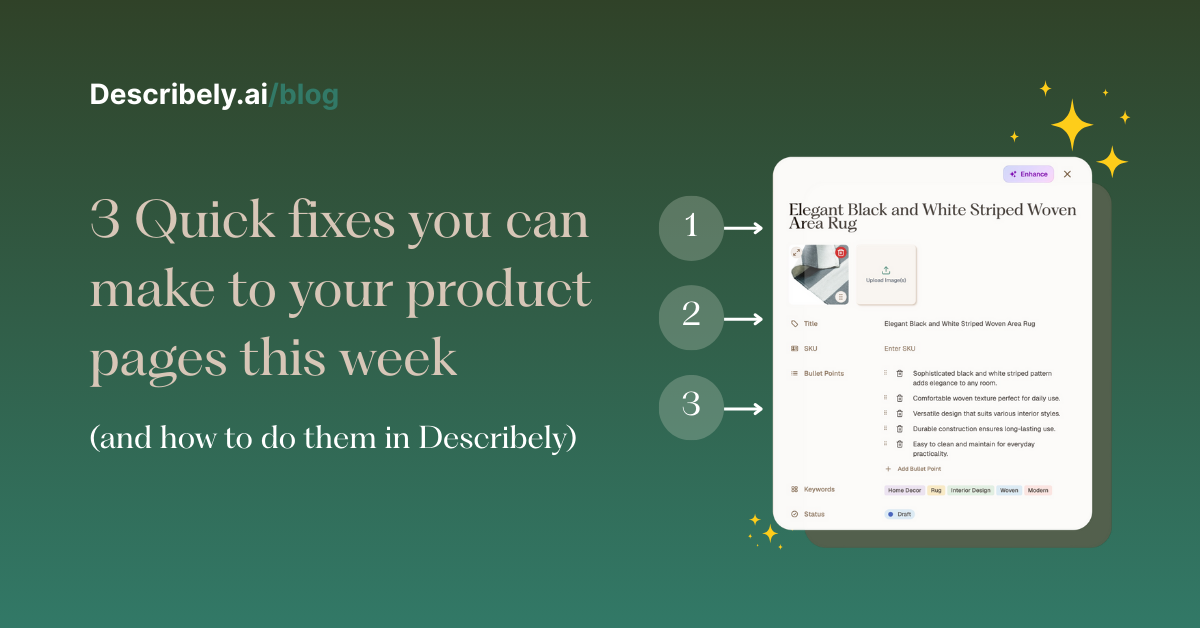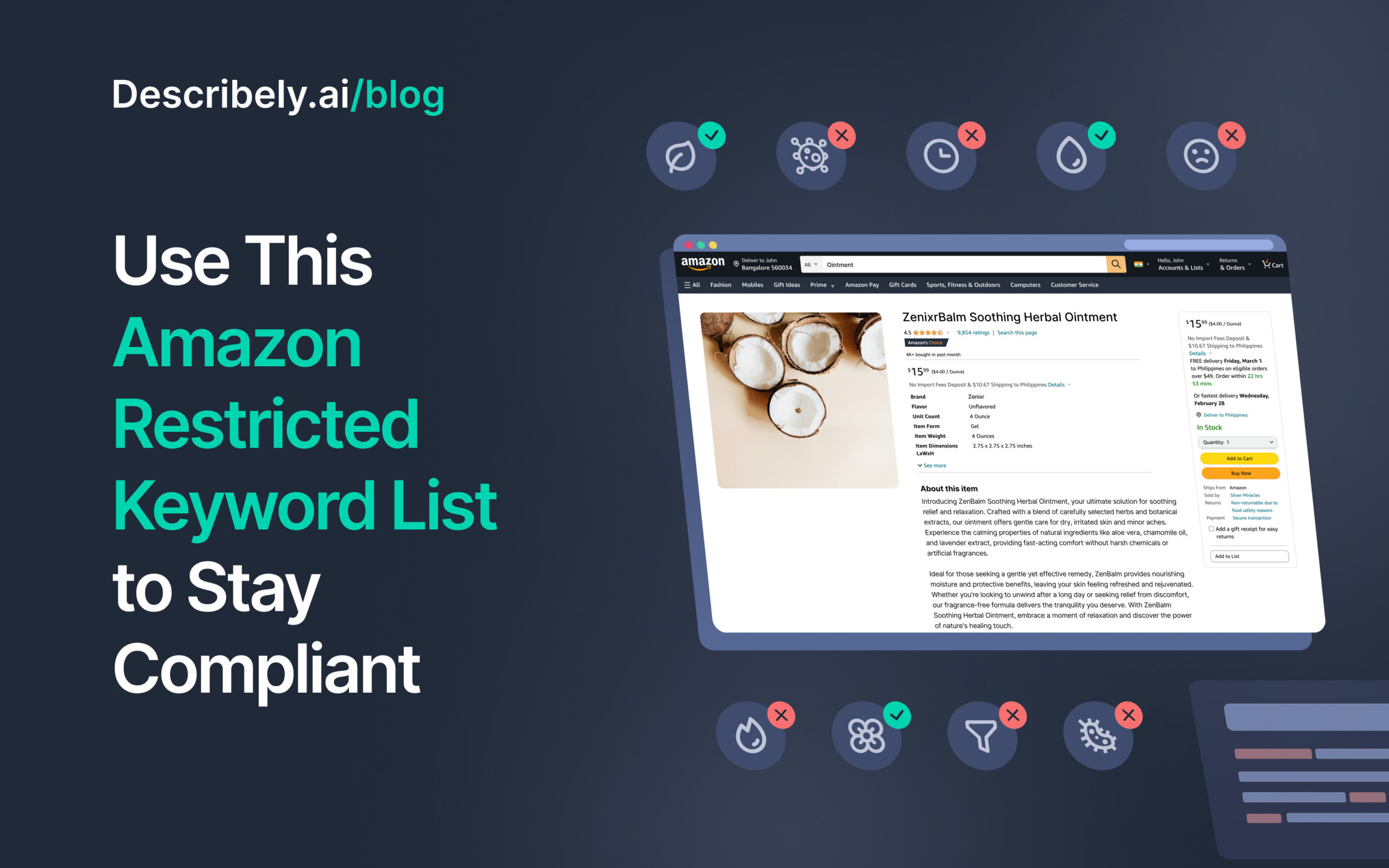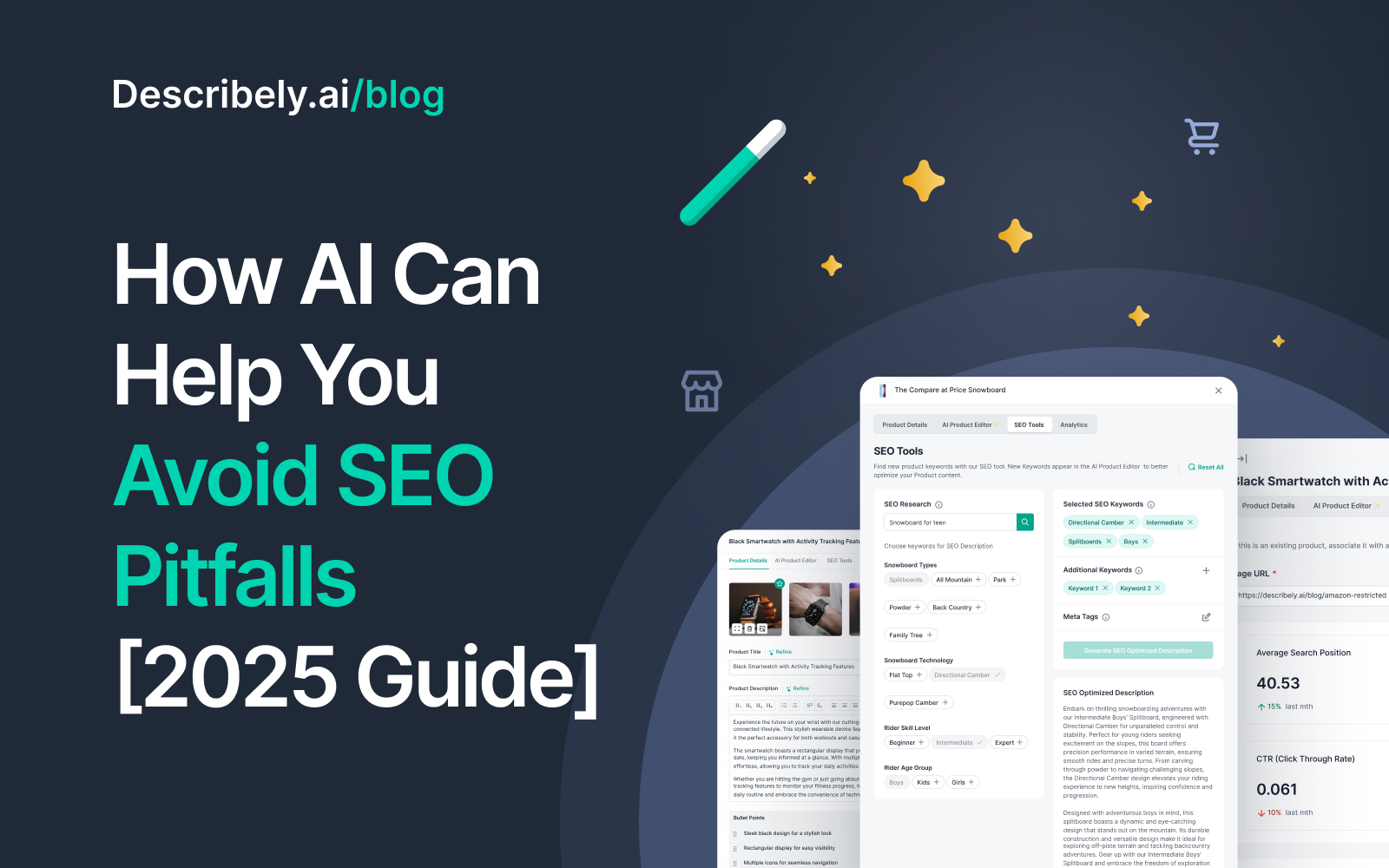
3 Quick fixes you can make to your product pages this week (and how to do them in Describely)
As a senior representative for Describely, I work with eCommerce teams every day, and I can tell you—sometimes it’s not the massive product page overhauls that move the needle. More often than not, it’s the small, simple fixes that can transform how your product pages perform. Too often, product descriptions get neglected, copied from suppliers, or left inconsistent—and that leaves shoppers confused or worse, unconvinced.
The good news? There are easy, high-impact adjustments you can make right now. In this post, I’ll walk you through three quick fixes you can apply to your product pages this week. These are the same strategies I share with eCommerce teams that want to compete at a higher level without needing a giant staff or endless time. And the best part is they’re easy to implement, especially if you’re using Describely.
Why optimizing product descriptions matters
Strong product content doesn’t just describe your products—it sells them. According to eCommerce research, shoppers are more likely to complete a purchase when they feel confident, they have all the details they need. On the flip side, poor product descriptions are one of the leading causes of abandoned carts (according to Stripe).
Optimized product descriptions:
- Build trust with shoppers.
- Improve SEO visibility with targeted keywords.
- Create brand consistency across your catalog.
- Reduce returns and complaints.
Now let’s break down three simple fixes you can tackle this week.
Quick fix 1: Add clear data points to support your product descriptions

The issue: Vague, fluffy copy like “durable” or “spacious” doesn’t mean much to a shopper. If I’m buying a backpack, I want to know the dimensions, material, weight, and whether it fits a laptop.
Why it matters: Shoppers make buying decisions based on facts. Missing or unclear details raise doubts and can lead to abandoned carts, negative reviews, or higher return rates. One of the fastest ways to lose trust is when a shopper feels like the brand is hiding something.
The fix: Enrich your product descriptions with clear, specific data points. Make sure every product page answers the top questions a shopper might have—before they even need to scroll to the FAQs or customer reviews. Think of your description as your best sales rep: it should anticipate and address hesitation right away.
How to do this in Describely:
- Use Product Data Enrichment to fill in missing details or enhance sparse supplier data.
- Import your catalog, and Describely generates polished descriptions with the right data points.
- Save hours of manual editing and ensure reliability across your entire catalog.
Pro tip: Highlight 3-5 of the most important data points near the top of your product description, This improves readability and builds shopper confidence.
Quick fix 2: Use shopper language from reviews in your product descriptions

The issue: Too many brands write in “brand-speak” and forget the language their customers actually use. Reviews, however, are a goldmine of real-world words and phrases.
Why it matters: Customer language builds trust and boosts both SEO and GEO. If reviews consistently mention that a product is “lightweight” or “perfect for travel,” those words should show up in your product descriptions too. Shoppers instantly recognize this language because it mirrors how they think and shop.
The fix: Mine your customer reviews for high-impact phrases and keywords, then weave them into your product descriptions. This bridges the gap between what customers say and how you describe your products.
How to do this in Describely:
- Use the Product Description Generator to automatically integrate high-performing keywords into every description.
- Feed in customer-sourced language, and Describely ensures your copy reflects how shoppers search.
- Boosts both authenticity and discoverability.
Pro tip: Pull phrases directly from 5-star reviews. If happy customers describe the product one way, new shoppers are likely to respond positively to the same language.
Quick fix 3: Make your product descriptions unique and on-brand

The issue: Copy-pasting from suppliers makes your product pages look identical to competitors’ pages. Search engines see it as duplicate content, and shoppers can’t tell why they should buy from you. They also differentiate your business in crowded market spaces.
Why it matters: Your brand’s voice is what makes you memorable. Unique, on-brand descriptions build trust and give shoppers a reason to choose you. They also differentiate your business in crowded marketplaces.
The fix: Create product descriptions that reflect your brand’s unique style and personality—and keep that style consistent across every product. Whether your voice is playful, technical, or sophisticated, let it shine.
How to do this in Describely:
- Use Content Rules to set guidelines for tone, length, formatting, and style.
- Every description aligns with your brand voice and stands out from copy-paste competition.
- Customize down to HTML formatting, word choice, and structure.
Pro tip: Keep a content style guide handy. Describely makes it easy to enforce that style at scale, but it helps to define your “do’s and don’ts” first.
Common product description mistakes to avoid
Over the years, I’ve spotted a few mistakes that hold ecommerce teams back:
- Overloading with jargon: Shoppers want clarity, not buzzwords. Words like “innovative” mean less than specifics like “battery life: 12 hours.”
- Keyword stuffing: Robotic copy damages trust and can hurt SEO performance.
- Inconsistency across products: Switching tone or structure makes your catalog feel unprofessional.
- Ignoring mobile formatting: Dense text blocks are hard to skim on phones. Break up content with bullets and spacing.
- Copy-pasting from suppliers: Duplicates content across the web, hurting both SEO and brand credibility.
Pro tip: Audit a handful of product pages every month to catch these mistakes early.
How Describely helps
Describely was built for ecommerce teams facing these exact challenges. Unlike generic AI tools, it’s designed specifically to:
- Enrich product data: give shoppers the details they need.
- Integrate customer language + high-performing keywords: improve visibility and trust.
- Lock in your brand voice: keep your catalog consistent and unique at scale.
And it’s not just about speed—it’s about accuracy, consistency, and impact. I’ve seen small teams with limited resources completely transform their product pages with Describely. Suddenly, they’re competing like enterprises without the cost or complexity.
Get started!
Small tweaks can lead to big results. By adding clear data points, weaving in customer language, and making your descriptions unique and on-brand, you can level up your product pages this week. These fixes are quick, practical, and high-impact.
And with Describely, you don’t have to do it all manually. These optimizations become fast, scalable, and tailored to your brand. That means less time editing in spreadsheets and more time focusing on growth.
Ready to take action? Get started with Describely today and turn your product pages into conversion engines that win shopper trust and boost your sales.
About the author

I’m Kayla Hesseltine, an ecommerce strategist at Describely. I love helping brands simplify product content, reduce friction for shoppers, and turn product pages into growth engines.



